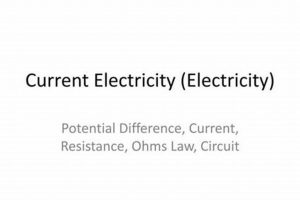Powering electric vehicles with electricity generated from sustainable sources like solar, wind, hydro, and geothermal offers a pathway to cleaner transportation. For instance, a solar array installed at a residence can charge a vehicle overnight, drawing directly from the sun’s energy. This approach contrasts with relying on electricity generated from fossil fuels, which contributes to greenhouse gas emissions.
Decarbonizing the transportation sector is crucial for mitigating climate change. Utilizing clean energy sources for vehicle charging significantly reduces the environmental impact of driving compared to gasoline-powered vehicles. Furthermore, advancements in battery technology and grid management are making this method increasingly practical and affordable. The shift towards sustainable transportation gained momentum as awareness of climate change and air quality concerns grew, driving innovation and investment in renewable energy infrastructure.
This article will explore the various renewable energy sources used for electric vehicle charging, delve into the technological advancements facilitating this transition, and examine the economic and environmental benefits of widespread adoption.
Tips for Sustainable Electric Vehicle Charging
Maximizing the environmental benefits of electric vehicles requires thoughtful charging practices. The following tips offer guidance on minimizing environmental impact and supporting a cleaner transportation future.
Tip 1: Optimize Charging Times: Whenever possible, charge vehicles during off-peak hours, typically at night. This helps balance grid load and often utilizes electricity generated from cleaner sources.
Tip 2: Explore Time-of-Use (TOU) Rates: Many utility companies offer TOU rates, providing lower electricity costs during off-peak periods, further incentivizing sustainable charging practices.
Tip 3: Consider Home Solar Installation: Integrating solar panels with a home charging setup allows direct use of solar energy, significantly reducing reliance on the grid and maximizing environmental benefits.
Tip 4: Support Renewable Energy Initiatives: Advocate for policies and programs that promote renewable energy development and grid modernization to expand access to clean electricity for transportation.
Tip 5: Research Green Power Programs: Many utilities offer green power programs enabling customers to support renewable energy generation even without home solar installations.
Tip 6: Utilize Smart Charging Technologies: Smart charging equipment can optimize charging based on grid conditions and renewable energy availability, further enhancing efficiency and sustainability.
Tip 7: Choose a Certified Green Electricity Supplier: Selecting a certified green electricity supplier ensures that the electricity used for charging comes from renewable sources.
By adopting these strategies, drivers can significantly reduce their carbon footprint and contribute to a more sustainable transportation ecosystem.
These practical steps empower individuals to actively participate in the transition towards cleaner transportation and a healthier planet. The following section will conclude with a call to action and future outlook.
1. Solar Integration
Solar integration plays a vital role in achieving sustainable electric vehicle (EV) charging. Directly harnessing solar energy to power EVs significantly reduces reliance on grid electricity generated from fossil fuels, thus minimizing greenhouse gas emissions and promoting cleaner transportation. This integration can occur at various levels, from individual residences with rooftop solar panels charging home-based EVs to larger-scale solar farms powering public charging stations. Cause-and-effect relationships are evident: increased solar energy generation directly leads to a greater capacity for clean EV charging, reducing dependence on carbon-intensive energy sources. For example, commercial properties installing solar canopies over parking areas can power EV charging stations on-site, offering a visible demonstration of this connection and providing a valuable service to customers.
The importance of solar integration as a component of renewable EV charging extends beyond individual benefits. Widespread adoption contributes to grid stability by reducing peak demand, particularly when combined with smart charging strategies. Furthermore, solar-powered EV charging enhances energy independence by diversifying energy sources and reducing reliance on centralized power generation. Practical applications include integrating solar with battery storage systems to enable EV charging even when sunlight is unavailable, such as overnight or during cloudy periods. This combination provides a resilient and reliable clean energy solution for EV charging, maximizing the environmental benefits. Consider a community solar project where subscribers receive credits on their utility bills for the solar energy generated, which can then be used to offset the cost of EV charging, further demonstrating the practical significance of this integration.
In summary, solar integration is crucial for establishing a sustainable EV charging infrastructure. It offers a pathway to decarbonizing the transportation sector, enhancing grid stability, and promoting energy independence. While challenges remain, such as the intermittency of solar power and the initial investment costs, ongoing technological advancements and supportive policies continue to drive wider adoption. The continued development and implementation of solar-powered EV charging solutions are essential for achieving a cleaner, more sustainable transportation future.
2. Wind Power Utilization
Wind power utilization represents a significant component of sustainable electric vehicle (EV) charging infrastructure. Harnessing wind energy to generate electricity offers a clean and renewable alternative to fossil fuel-based sources, reducing greenhouse gas emissions associated with transportation. The cause-and-effect relationship is clear: increased wind power generation translates directly into greater capacity for emissions-free EV charging. For example, a wind farm located near a highway can power nearby charging stations, directly linking clean energy production with transportation needs. This connection underscores the importance of wind power as a component of a comprehensive renewable energy strategy for EV charging. Furthermore, the variability of wind resources necessitates effective grid management strategies, such as integrating energy storage solutions to ensure a reliable power supply for EV charging even during periods of low wind activity. This integration highlights the practical significance of understanding the complexities of wind power utilization within the context of sustainable transportation.
Practical applications of wind-powered EV charging are increasingly evident. Businesses can install on-site wind turbines to power EV charging stations for their fleets or customers, demonstrating a commitment to sustainability while reducing operational costs. Similarly, municipalities can incorporate wind power into their public transportation infrastructure, powering electric bus fleets and public charging networks. These examples showcase the tangible benefits of integrating wind energy into EV charging infrastructure. Furthermore, advancements in wind turbine technology and energy storage solutions are continually improving the efficiency and reliability of wind-powered EV charging, making it an increasingly viable and attractive option. For instance, offshore wind farms, which often benefit from stronger and more consistent winds, can contribute significantly to powering coastal communities and their transportation needs.
In conclusion, wind power utilization is essential for building a robust and sustainable EV charging infrastructure. Its integration supports decarbonization efforts within the transportation sector, reduces reliance on finite fossil fuels, and enhances energy independence. While challenges remain, such as the intermittent nature of wind and potential environmental impacts, careful planning and technological advancements are mitigating these concerns. Continued investment in and development of wind-powered EV charging solutions are crucial for transitioning towards a cleaner and more sustainable transportation future. This transition necessitates a holistic approach that considers grid stability, energy storage, and the complementary roles of other renewable energy sources in achieving a truly sustainable transportation ecosystem.
3. Grid Management Strategies
Effective grid management is crucial for successfully integrating renewable energy sources into electric vehicle (EV) charging infrastructure. The intermittent nature of renewable energy generation, such as solar and wind power, necessitates sophisticated strategies to ensure a stable and reliable power supply for EV charging. A cause-and-effect relationship exists: fluctuations in renewable energy generation require dynamic grid management to prevent disruptions to EV charging services. This underscores the importance of grid management as a fundamental component of sustainable EV charging infrastructure. For example, smart grids equipped with advanced sensors and communication technologies can monitor real-time energy demand and adjust power distribution accordingly, optimizing the use of renewable energy sources while maintaining grid stability. This integration allows for efficient allocation of renewable energy resources, minimizing reliance on fossil fuel-based power plants during peak charging periods. Understanding this interconnectedness is crucial for developing effective solutions for sustainable transportation.
Practical applications of grid management strategies in the context of EV charging include time-of-use (TOU) pricing, which incentivizes charging during off-peak hours when renewable energy generation is often higher and demand is lower. This not only reduces strain on the grid but also encourages consumers to utilize cleaner energy sources for their EV charging needs. Furthermore, demand response programs can leverage smart charging technologies to manage EV charging loads in response to grid conditions, further enhancing grid stability and optimizing the utilization of renewable energy. For instance, during periods of high energy demand, smart charging systems can temporarily reduce or delay charging for participating EVs, preventing grid overload and maximizing the use of available renewable energy resources. These practical examples demonstrate the significance of integrating grid management strategies into the broader context of sustainable EV charging infrastructure.
In conclusion, robust grid management strategies are indispensable for maximizing the benefits of renewable energy integration within EV charging infrastructure. Addressing the challenges posed by the intermittent nature of renewable energy sources requires sophisticated grid management systems capable of balancing supply and demand, optimizing energy distribution, and ensuring grid stability. While challenges remain in terms of infrastructure development and cost, ongoing advancements in smart grid technologies and energy storage solutions are paving the way for a more resilient and sustainable transportation future. The effective integration of these strategies is crucial for realizing the full potential of renewable energy in powering EV charging and decarbonizing the transportation sector. This necessitates a holistic approach that considers not only technological advancements but also policy frameworks and consumer behavior to achieve a truly sustainable transportation ecosystem.
4. Battery Storage Solutions
Battery storage solutions play a critical role in enabling the widespread adoption of renewable energy for electric vehicle (EV) charging. The intermittent nature of renewable energy sources, such as solar and wind power, necessitates robust energy storage systems to ensure a consistent and reliable power supply for EV charging, regardless of weather conditions or time of day. This connection underscores the importance of battery storage as a key enabler of sustainable transportation powered by renewable energy.
- Grid Stability and Reliability
Battery storage systems enhance grid stability by absorbing excess renewable energy generated during periods of high production and releasing it during periods of low production or peak demand. This buffering effect mitigates fluctuations in renewable energy supply, ensuring a consistent flow of electricity to EV charging stations. For instance, a large-scale battery installation connected to a solar farm can store excess solar energy generated during the day and discharge it in the evening when solar production declines but EV charging demand increases. This capability enhances grid reliability and reduces the need for fossil fuel-based peaker plants, further contributing to the decarbonization of the transportation sector.
- Maximizing Renewable Energy Utilization
Battery storage maximizes the utilization of renewable energy by capturing excess generation that might otherwise be curtailed. This is particularly relevant for solar and wind power, which can experience periods of overproduction. By storing this surplus energy, battery systems ensure that a greater portion of renewable energy generation is used productively for EV charging, minimizing reliance on fossil fuel-based electricity generation and reducing greenhouse gas emissions. For example, a commercial building with rooftop solar panels can store excess solar energy generated during the day in batteries and use it to power EV charging stations for employees and visitors, maximizing the building’s self-consumption of renewable energy.
- Enabling Off-Grid and Remote EV Charging
Battery storage solutions enable EV charging in off-grid or remote locations where grid access is limited or unavailable. This expands the reach of EV charging infrastructure beyond urban centers, facilitating the adoption of EVs in rural areas and supporting sustainable transportation in diverse environments. For instance, a remote tourism lodge can install a solar-plus-battery system to power EV charging stations for guests, promoting sustainable tourism practices and reducing reliance on diesel generators. This capability expands access to EV charging and supports the decarbonization of transportation in areas beyond the reach of traditional grid infrastructure.
- Supporting Vehicle-to-Grid (V2G) Technologies
Battery storage systems are essential for enabling vehicle-to-grid (V2G) technologies, which allow EVs to act as mobile energy storage units, supplying electricity back to the grid during periods of high demand or outages. This bi-directional flow of energy enhances grid flexibility and resilience, while also providing potential revenue streams for EV owners. For example, an aggregation platform can coordinate the charging and discharging of a fleet of V2G-enabled EVs, providing grid services and supporting renewable energy integration. This capability transforms EVs into valuable grid assets, further enhancing the role of battery storage in building a sustainable and resilient energy system.
In summary, battery storage solutions are essential for integrating renewable energy sources into EV charging infrastructure, addressing the intermittency challenges of renewable energy and ensuring a reliable and sustainable power supply for EV charging. The various facets of battery storage, including grid stabilization, maximizing renewable energy utilization, enabling off-grid charging, and supporting V2G technologies, collectively contribute to the decarbonization of the transportation sector and the transition towards a cleaner and more sustainable energy future. As battery technology continues to advance and costs decline, the role of battery storage in supporting renewable EV charging will only become more prominent, paving the way for a truly sustainable transportation ecosystem.
5. Policy and Incentives
Government policies and incentives play a crucial role in accelerating the adoption of renewable energy for electric vehicle (EV) charging. These interventions address market barriers, stimulate investment, and create a supportive environment for the transition to sustainable transportation. Effective policies and incentives can significantly influence consumer behavior, business decisions, and technological advancements, driving the growth of renewable EV charging infrastructure and contributing to broader environmental goals.
- Financial Incentives for Renewable Energy Integration
Financial incentives, such as tax credits, rebates, and grants, can reduce the upfront costs of installing renewable energy generation and storage systems for EV charging. These incentives can target both residential and commercial consumers, encouraging the deployment of solar panels, wind turbines, and battery storage solutions. For example, a federal tax credit for residential solar installations can make it more financially attractive for homeowners to install solar panels and charge their EVs with clean energy. Similarly, grants for businesses to install EV charging stations powered by renewable energy can incentivize the private sector to invest in sustainable transportation infrastructure. These financial mechanisms directly influence market adoption and accelerate the transition to renewable EV charging.
- Renewable Portfolio Standards (RPS) and Clean Energy Mandates
Renewable Portfolio Standards (RPS) and clean energy mandates require electricity providers to source a certain percentage of their electricity from renewable sources. These policies create demand for renewable energy, driving investment in renewable energy projects and indirectly supporting the growth of renewable EV charging. For instance, a state with an RPS requiring 50% of electricity to come from renewable sources by 2030 creates a market for renewable energy developers, which in turn increases the availability of clean electricity for EV charging. These mandates establish a regulatory framework that promotes the growth of renewable energy generation, indirectly supporting the expansion of renewable EV charging infrastructure.
- Building Codes and Zoning Regulations
Building codes and zoning regulations can be leveraged to promote the integration of renewable energy and EV charging infrastructure in new construction and renovations. For example, requiring new commercial buildings to include EV charging stations and on-site renewable energy generation, such as solar panels, can ensure that new developments are equipped to support sustainable transportation. Similarly, zoning regulations can streamline the permitting process for installing rooftop solar panels and EV chargers in residential areas, removing barriers to adoption. These regulations create a supportive environment for renewable EV charging by integrating sustainability considerations into the built environment.
- Emission Standards and Vehicle Electrification Targets
Stringent emission standards for vehicles and ambitious vehicle electrification targets create a market pull for EVs, indirectly driving the demand for renewable EV charging infrastructure. For example, a national target to achieve 100% EV sales by 2035 creates a strong incentive for automakers to produce more EVs and for charging infrastructure providers to expand their networks. As the number of EVs on the road increases, the demand for renewable EV charging grows correspondingly. These policies create a synergistic effect, driving the adoption of both EVs and the renewable energy infrastructure needed to support them.
The interplay of these policy and incentive mechanisms is crucial for creating a comprehensive ecosystem that supports the widespread adoption of renewable EV charging. By addressing financial barriers, creating market demand, and establishing supportive regulations, policymakers can accelerate the transition to sustainable transportation, reduce greenhouse gas emissions, and promote a cleaner energy future. Furthermore, the effectiveness of these policies can be enhanced through ongoing evaluation and adaptation to ensure they remain aligned with evolving technological advancements and market dynamics. Ultimately, a well-designed policy landscape is essential for unlocking the full potential of renewable energy in powering EV charging and achieving a truly sustainable transportation system.
Frequently Asked Questions about Renewable Energy Powered EV Charging
This section addresses common inquiries regarding the utilization of renewable energy sources for electric vehicle charging.
Question 1: How significantly does using renewable energy reduce the environmental impact of EV charging?
Charging an EV with renewable energy dramatically reduces greenhouse gas emissions compared to using electricity generated from fossil fuels. The extent of the reduction depends on the specific renewable energy source and the energy mix of the local grid. Lifecycle assessments provide comprehensive comparisons.
Question 2: What are the primary barriers to wider adoption of renewable energy powered EV charging?
Key barriers include the intermittency of renewable energy sources, the upfront costs of renewable energy installations, and the need for robust grid infrastructure to support increased EV charging demand. Technological advancements and supportive policies are addressing these challenges.
Question 3: Can one charge an EV with renewable energy at home?
Residential EV charging with renewable energy is readily achievable through rooftop solar installations, participation in community solar programs, or selecting a green electricity tariff from a utility provider.
Question 4: Is renewable energy powered EV charging more expensive than conventional charging?
While the initial investment for renewable energy infrastructure, such as solar panels, can be significant, long-term operational costs are often lower due to reduced reliance on grid electricity. Furthermore, government incentives can offset initial expenses.
Question 5: How does the intermittent nature of renewable energy sources impact the reliability of EV charging?
Grid management strategies, such as smart charging and energy storage solutions, mitigate the intermittency challenges of renewable energy sources, ensuring a reliable power supply for EV charging. Battery storage systems can store excess renewable energy for use during periods of low generation.
Question 6: What role do government policies play in promoting renewable energy powered EV charging?
Supportive policies, such as financial incentives, renewable portfolio standards, and building codes, play a crucial role in accelerating the adoption of renewable energy for EV charging. These interventions can stimulate investment, reduce market barriers, and create a favorable environment for sustainable transportation.
Addressing these common questions provides clarity regarding the benefits and challenges of integrating renewable energy with EV charging infrastructure. This understanding is crucial for informed decision-making and for promoting a sustainable transportation future.
The following section will explore the future of renewable energy powered EV charging.
Conclusion
This exploration of electric vehicle charging powered by renewable energy sources has highlighted the critical intersection of sustainable transportation and clean energy. Key takeaways include the significant environmental benefits of utilizing renewable energy for EV charging, the importance of grid management strategies and energy storage solutions in addressing the intermittency of renewable generation, and the crucial role of supportive government policies and incentives in accelerating market adoption. The analysis further emphasized the technological advancements driving innovation in this field, such as smart charging technologies, vehicle-to-grid (V2G) integration, and advancements in battery storage capacity and efficiency. The convergence of these factors underscores the growing viability and importance of renewable energy in powering the future of transportation.
The transition to widespread adoption of electric vehicle charging powered by renewable energy represents a fundamental shift towards a more sustainable and resilient transportation ecosystem. Continued investment in research and development, coupled with supportive policy frameworks, will be crucial for overcoming remaining challenges and realizing the full potential of this transformative technology. The integration of renewable energy with EV charging infrastructure offers a pathway not only to decarbonize the transportation sector but also to enhance grid stability, promote energy independence, and contribute to a cleaner, healthier environment for future generations. The imperative for sustainable transportation necessitates a collective commitment to innovation, collaboration, and decisive action to accelerate this transition.







